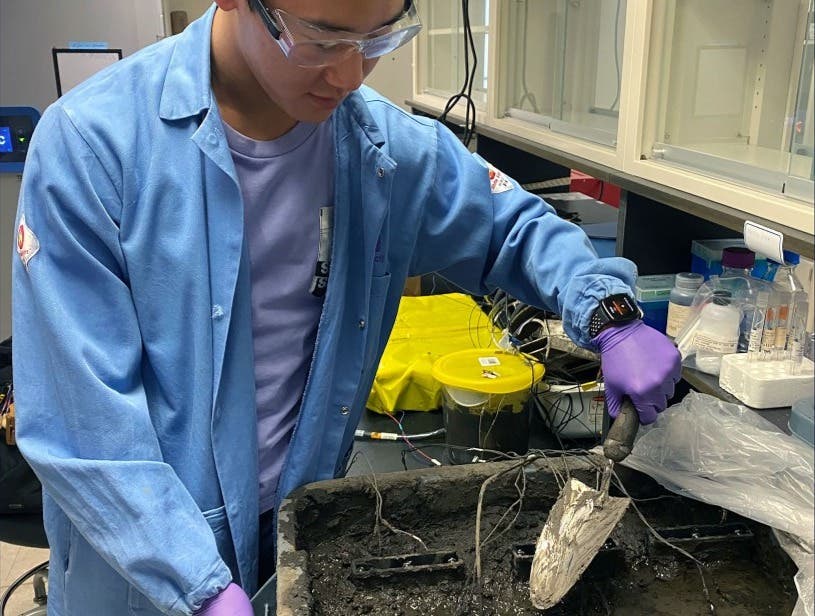Revolutionary dirt-powered fuel cell runs forever, study finds
In a groundbreaking development, a team of researchers has unveiled a novel fuel cell that harnesses energy from microbes residing in soil

[Jan. 19, 2024: JD Shavit, The Brighter Side of News]
Working in the lab, Northwestern alumnus Bill Yen buries the fuel cell in soil. (CREDIT: Bill Yen/Northwestern University)
In a groundbreaking development, a team of researchers led by Northwestern University has unveiled a novel fuel cell that harnesses energy from microbes residing in soil.
This innovative technology, roughly the size of a standard paperback book, holds the potential to power underground sensors used in precision agriculture and green infrastructure, offering a sustainable and renewable alternative to conventional batteries with their harmful chemicals and environmental drawbacks.
The newly devised fuel cell demonstrated its capabilities by powering sensors responsible for measuring soil moisture and detecting touch. The latter function could prove invaluable in tracking the movement of animals in the vicinity.
Additionally, to facilitate wireless communication, the research team equipped the soil-powered sensor with a miniature antenna capable of transmitting data to a nearby base station by reflecting existing radio frequency signals.
Related Stories
What sets this fuel cell apart is its adaptability, working effectively in both wet and dry conditions. Impressively, it outlasted similar technologies by an impressive margin, boasting 120% greater endurance.
Published in the Proceedings of the Association for Computing Machinery on Interactive, Mobile, Wearable and Ubiquitous Technologies, this research not only introduces an innovative solution but also takes a commendable step towards open collaboration.
The study authors have generously shared all designs, tutorials, and simulation tools with the public, fostering an environment where others can build upon their groundbreaking work.
The clean fuel cell in the lab. (CREDIT: Bill Yen/Northwestern University)
Bill Yen, an alumnus of Northwestern and the leader of this endeavor, emphasized the importance of finding alternatives to traditional batteries in our increasingly interconnected world, stating, "The number of devices in the Internet of Things (IoT) is constantly growing. If we imagine a future with trillions of these devices, we cannot build every one of them out of lithium, heavy metals, and toxins that are dangerous to the environment. We need to find alternatives that can provide low amounts of energy to power a decentralized network of devices. In a search for solutions, we looked to soil microbial fuel cells, which use special microbes to break down soil and use that low amount of energy to power sensors. As long as there is organic carbon in the soil for the microbes to break down, the fuel cell can potentially last forever."
The magic behind this technology lies in the ubiquity of the microbial life forms present in soil. These microbes, as George Wells from Northwestern's McCormick School of Engineering explains, are "ubiquitous; they already live in soil everywhere."
The fuel cell, coated in dirt after being pulled from the ground. (CREDIT: Bill Yen/Northwestern University)
The research team has devised straightforward systems to capture the electricity generated by these microbes, resulting in a revolutionary approach to harnessing energy. Wells emphasizes that this won't power entire cities but will provide small amounts of energy to fuel practical, low-power applications.
One of the key applications targeted by this groundbreaking technology is precision agriculture, which has seen increasing adoption by farmers worldwide. Precision agriculture relies heavily on electronic devices that continuously collect environmental data, such as soil moisture levels, nutrient content, and contaminant presence, to make informed decisions that optimize crop health and yield.
The fuel cell's 3D printed cap peeks above the ground. The cap keeps debris out of the device while enabling air flow. (CREDIT: Bill Yen/Northwestern University)
However, deploying electronic sensors in remote or challenging environments presents a significant challenge, primarily due to the limitations of conventional batteries and solar panels.
As Bill Yen points out, "Solar panels don't work well in dirty environments because they get covered with dirt, do not work when the sun isn't out and take up a lot of space. Batteries also are challenging because they run out of power. Farmers are not going to go around a 100-acre farm to regularly swap out batteries or dust off solar panels." To address these constraints, the Northwestern-led team looked to harness energy from the soil itself, which is already being monitored by farmers.
Soil-based microbial fuel cells (MFCs) have been around since 1911, operating similarly to batteries with an anode, cathode, and electrolyte. However, unlike conventional batteries, MFCs rely on bacteria that naturally donate electrons to nearby conductors to generate electricity.
This flow of electrons from the anode to the cathode creates an electric circuit, essentially powering the fuel cell. However, for MFCs to function optimally, they require consistent hydration and oxygenation, conditions that can be challenging to maintain when buried underground in dry soil.
Bill Yen and his team embarked on a two-year journey to develop a practical and reliable soil-based MFC. They designed and compared four different prototypes, collecting nine months of performance data for each design. The best-performing version excelled in both dry and waterlogged conditions, owing its success to its unique geometry. Unlike traditional MFCs, where the anode and cathode are parallel to each other, this winning fuel cell employed a perpendicular design.
The anode, made of carbon felt, lies horizontally just beneath the soil's surface, while the cathode, constructed from an inert, conductive metal, stands vertically above the anode. This vertical design ensures that the top end of the fuel cell remains flush with the ground's surface, with a 3D-printed cap protecting it from debris.
The design places a disc-shaped anode at the bottom, and a vertically-oriented anode poking up towards the surface. (CREDIT: Bill Yen/Northwestern University)
An opening at the top and an adjacent empty air chamber facilitate consistent airflow. The lower end of the cathode remains deep in the soil, ensuring hydration from the surrounding moisture. Moreover, the cathode's part is coated with waterproofing material, allowing it to breathe during floods and ensuring gradual drying after flooding.
On average, this innovative fuel cell generated 68 times more power than required to operate its sensors and proved resilient in the face of significant fluctuations in soil moisture levels, from moderately dry (41% water by volume) to completely submerged.
In addition to its groundbreaking potential, this technology promises to simplify supply chains and reduce dependence on conflict minerals. Josiah Hester, a co-author of the study, emphasized the importance of building devices with local supply chains and low-cost materials, making computing accessible to all communities.
Note: Materials provided above by The Brighter Side of News. Content may be edited for style and length.
Like these kind of feel good stories? Get the Brighter Side of News' newsletter.



